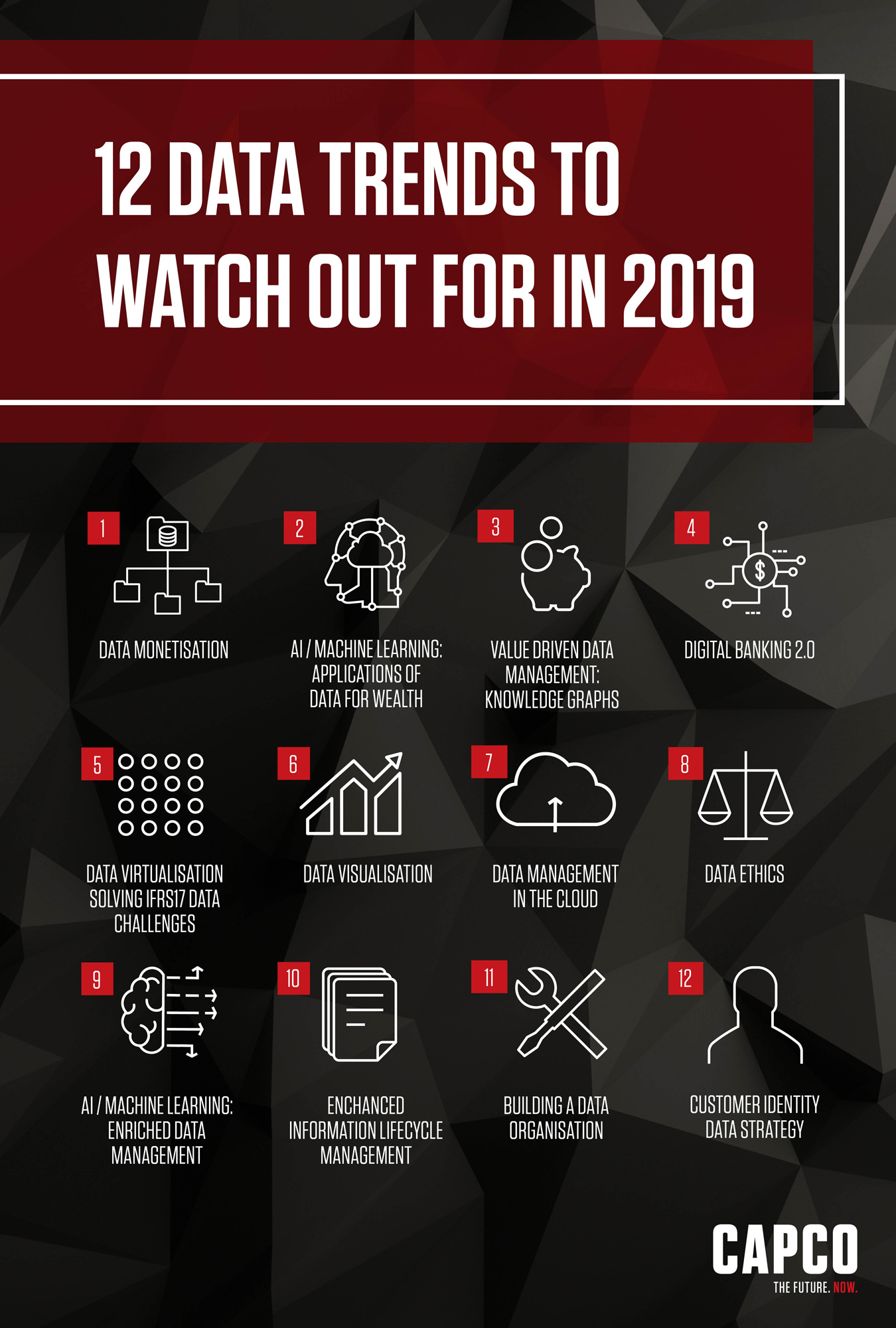12 DATA DIFFERENTIATORS FOR 2019
- Published: 13 March 2019
It’s an often-peddled fact that over 2.5 quintillion (that’s 18 zeroes) bytes of data are created every day. The pace of data creation is only accelerating, with data buzzwords trailing not far behind. How can firms truly understand ‘the next big thing’, if there’s a new ‘thing’ every fortnight?
2018 saw growing business buy-in to data management. This was primarily driven by regulations, with GDPR being a prime example. Regulatory focus on data is only planned to increase in 2019 – and with it too the investment in data management. This year we will see a key shift however, as banks use regulatory delivery to realise business value, having gained a detailed understanding of their data and its movement around the organisation.
Digital transformation cannot happen overnight, and there is no silver bullet which can change that. 2019 will see significant investment to make enterprise data architecture robust, flexible and scalable enough to support the integration of the growing number of cloud-based data sources, digital assets and applications underpinning the fast-moving digital business models of today’s banks.
2018 was the year artificial intelligence and machine learning stopped being considered as a work of science fiction, but a true enabler to drawing actionable insights from data. Strategic adoption of data analytics within major financial institutions still however remains a key challenge. This year, we expect to see a drive from the top for bank-wide consistency in analytics operations, creating a skilled analytics workforce and reducing time-to-insights.
To help make sense of this ever-changing landscape, here’s our view of the 12 data differentiators for 2019.
1. Data Monetisation
Banks will begin to capitalise on their greatest asset as the data marketplace grows. The role of banks, intermediaries & brokerages and their use of technology and data will change due to recent developments in open banking, facilitating the sharing of data.
2. AI / Machine Learning – Applications of data for wealth
Wealth firms will be able to provide algorithm-based retirement strategies that are driven by data collected from assets, trades, interactions and behaviour analytics to ultimately serve a growing demand from ageing populations in developed countries.
3. Value Driven Data Management: Knowledge Graphs
Investment in data management will not only enable financial institutions to meet growing regulatory demands, but also gain significant competitive advantage through deriving value from data. Firms will uncover immense value through the development of knowledge graphs and curation of data, allowing the right data, with the right context, to be sourced at the right time.
4. Digital Banking 2.0
Financial institutions will enhance their data management capability to gain new insights and enhance the digital banking customer experience. New channels through mobile and apps will be used as growing sources for data collection used for commercialisation and insights.
5. Data Virtualisation - Solving IFRS17 Data Challenges
Insurance firms will use data virtualisation as a quick and effective approach to meet the granularity of reporting required for IFRS17.
6. Data Visualisation
Business Intelligence solutions have become an important tool in enabling companies to make smart, data-driven decisions. The next step is giving power to the users - not only will companies need the technical capabilities to offer self-service to business users, but they will also need to carefully assign access and permissions per user and per role. As more data becomes more easily available we will continue to see a shift from BI being used just to interpret and represent data and more towards BI also acting as a “center of excellence” – a way to keep relevant and powerful data quickly accessible and shareable
7. Data Management in the Cloud
The movement of data to the cloud will provide banks with a number of opportunities to transform their data management capability.
8. Data Ethics
Financial institutions will face enhanced scrutiny of their data ethics in the wake of significant breaches of trust in 2018. Banks must not only continue to enhance transparency, but also build consumer trust in the decisions made by a face which is becoming increasingly less human.
9. AI / Machine Learning – Enhanced Data Management
The CDO will scale using machine learning-enabled data management solutions, addressing increased regulatory demands whilst reducing cost on labour-intensive manual methods.
10. Enhanced information lifecycle management
Hefty GDPR fines will increase focus on financial institutions' abilities to store and retrieve information. In addition, cost pressures will force firms to improve their frameworks for disposal of records. File analysis solutions will become more prevalent, allowing banks to automatically build a greater picture of all instances of PII across the organisation and dispose data easily once legal obligations are met.
11. Building a Data Organisation
CEOs will build organisational muscle in data and analytics. Opportunities exist to enhance efficiency and effectiveness of analytics activities in both the short and long-term.
12. Customer Identity Data Strategy
Defining a data strategy that accurately and consistently manages a customer’s identity across the whole organisation allows financial institutions to streamline operational processes and optimise the customer experience. Customers, both businesses and individuals, will begin to expect this and leave financial institutions who fail to invest early in an appropriate data strategy.
For more information about our predictions, please reach out to Chris Probert, Partner, Data Practice.
